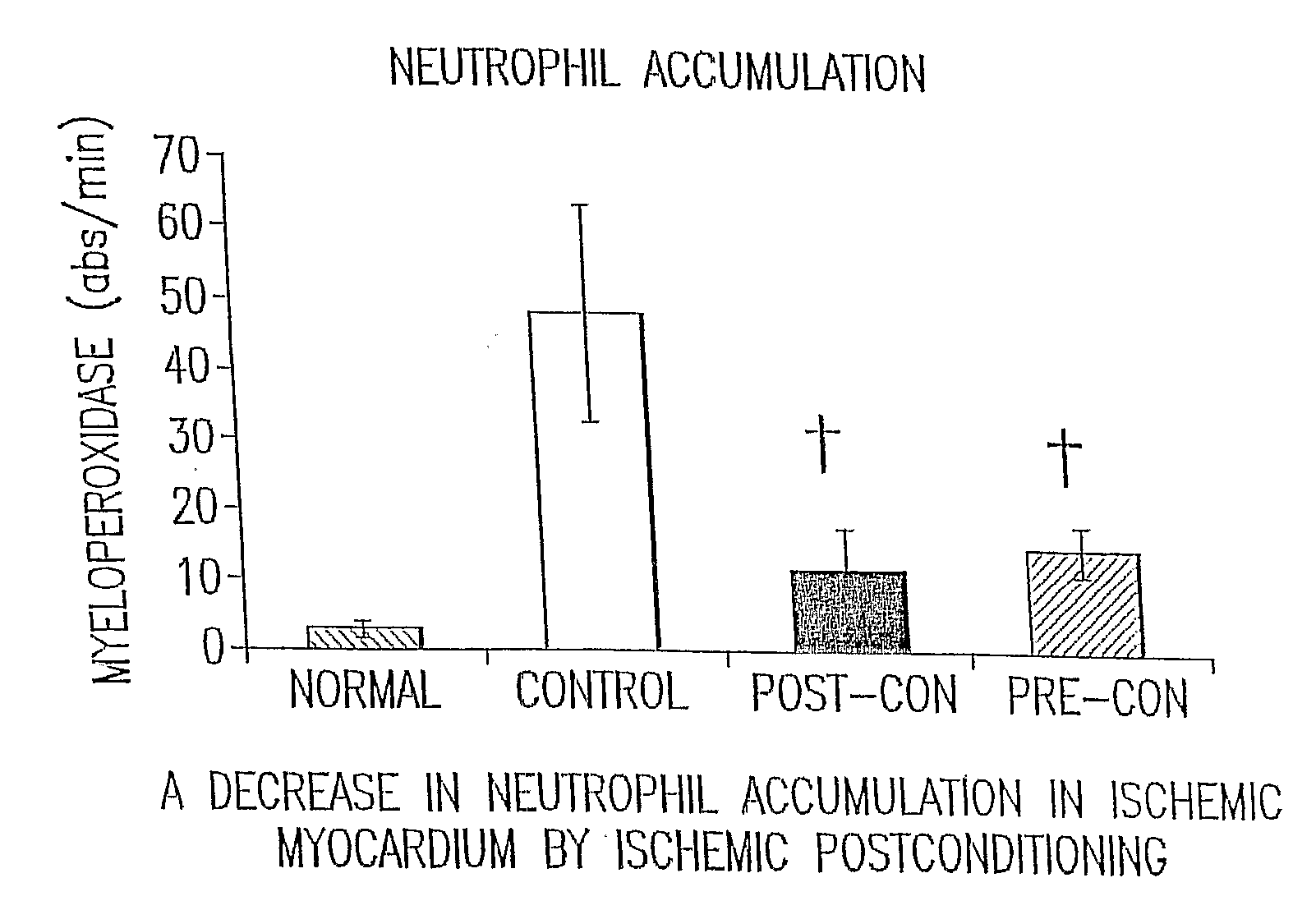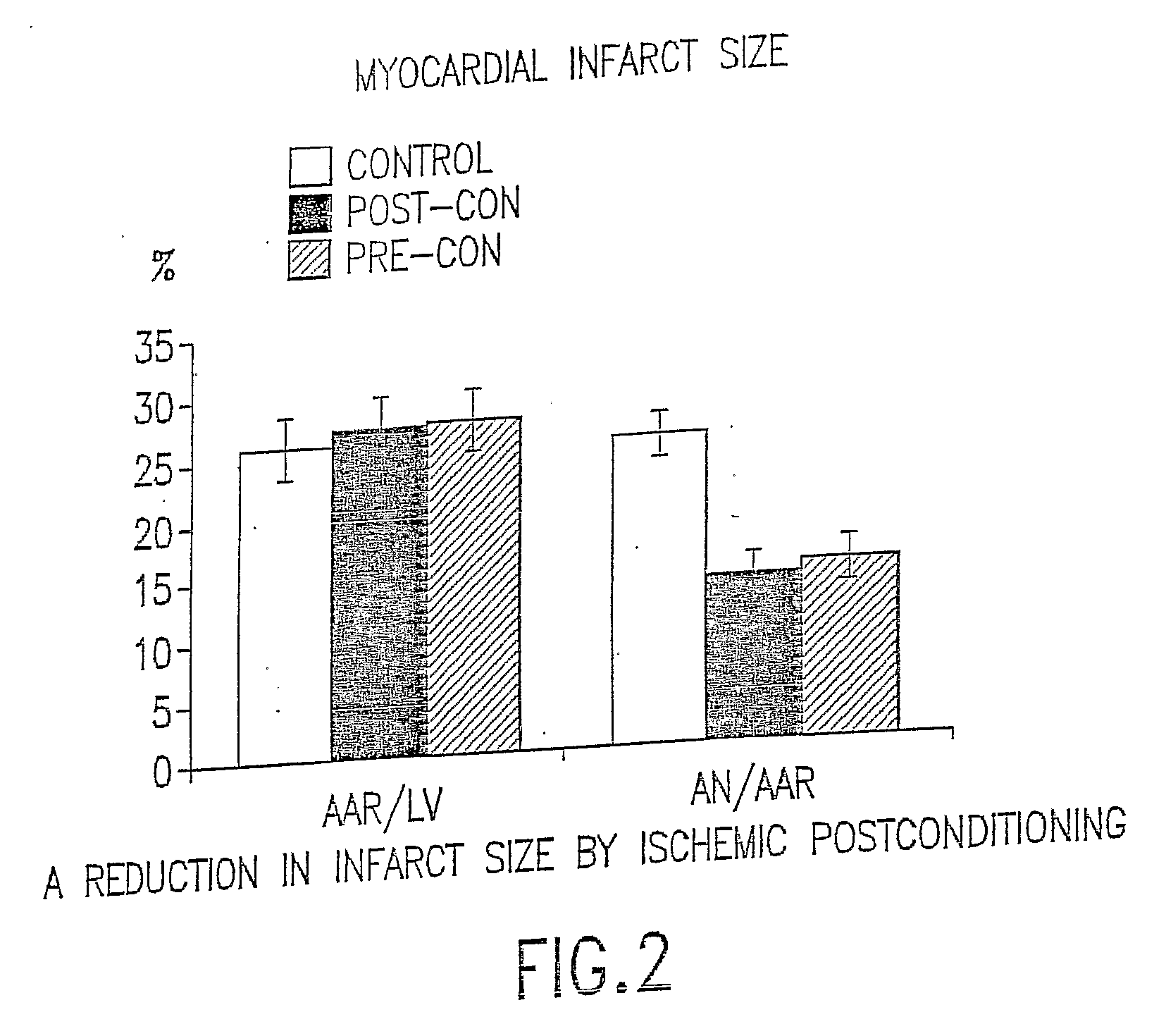Therapeutic Adjuncts to Enhance the Organ Protective Effects of Postconditioning
a postconditioning and organ protective effect technology, applied in the direction of biocide, anti-noxious agents, drug compositions, etc., can solve the problems of focal necrosis of the heart tissue, premature, permanent disability, and organ or tissue injury, so as to prevent injury to the organ or tissue, and prevent the effect of heart injury
- Summary
- Abstract
- Description
- Claims
- Application Information
AI Technical Summary
Benefits of technology
Problems solved by technology
Method used
Image
Examples
example 1
[0057] The concept of postconditioning was tested in an opened-chest canine model of regional myocardial ischemia and reperfusion. All animals were randomly assigned to one of the following three groups (FIG. 1): 1) Control: the left anterior descending coronary artery (LAD) was reversibly occluded for 60 minutes, and the ischemic myocardium was then reperfused for 3 hours; 2) ischemic postconditioning (Post-con): after 60 minutes of LAD occlusion, the ischemic myocardium was initially reperfused using 3 cycles of repetitively applied reperfusion followed by re-occlusion of the coronary artery, i.e., 30 seconds of reperfusion followed by 30 seconds of occlusion repeated in 3 successive cycles; 3) ischemic preconditioning (Pre-con): 5 minutes of LAD occlusion and 10 minutes of reperfusion were performed before the 60 minutes of myocardial ischemia.
[0058]FIGS. 1-9 show the salutary effects of postconditioning on the ischemic / reperfused heart. Those effects include reduction in infarc...
example 2
[0063] Postconditioning can be enhanced by pharmacological means which capture the protective actions of the proximal mediators such as adenosine and opioids. In a rat model of myocardial infarction, it can be shown that the dual approach of attenuating reperfusion injury by applying postconditioning in the presence of a sodium-hydrogen exchange (NHE-1) inhibitor during early reperfusion achieves greater infarct size reduction than either intervention alone [48]. Specifically, in an anesthetized rat model, the left coronary artery (LCA) was occluded for 30 min of ischemia (I) and reperfused for 3 hours. Rats were randomly divided into six groups (n=8 each) (FIG. 10): Control: no intervention at reperfusion; Postconditioning: three cycles of 10-s reperfusion followed by 10-s re-occlusion were applied during the first minute of reperfusion; NHE(1): cariporide (1 mg / kg) was infused 5 min before reperfusion, with or without postconditioning; Delayed (D)-NHE(1): a 5-minute infusion of ca...
example 3
[0064] Adenosine is a mediator of the cardioprotection of postconditioning. Isolated-perfused mouse hearts were subjected to 20 min global ischemia (I) and 30 min reperfusion (R) with or without Postcon (6 cycles of 10 sec. R & occlusion). Intravascular purines in coronary effluent were analyzed by HPLC. To determine whether endogenous adenosine played a physiological role in postconditioning, the left coronary artery (LCA) was occluded for 30 min and reperfused for 3 hours in anesthetized open-chest rats. The rats were randomly divided into six groups (n=8 each): Control (no intervention); postconditioning (3 cycles of 10-s R followed by 10-s LCA I before 3 hours R); 8-SPT (subtype non-selective adenosine receptor antagonist, 10 mg / kg), or ZW241385 (A2a receptor antagonist, 0.2 mg / kg), was given 5 min before R with or without postconditioning.
[0065] In mouse hearts, postconditioning decreased effluent [adenosine] at 2 min R (58±5* vs 155±16 nM / min / g), and improved contractile funct...
PUM
| Property | Measurement | Unit |
|---|---|---|
| end-diastolic pressure | aaaaa | aaaaa |
| end-diastolic pressure | aaaaa | aaaaa |
| size | aaaaa | aaaaa |
Abstract
Description
Claims
Application Information
 Login to View More
Login to View More - R&D
- Intellectual Property
- Life Sciences
- Materials
- Tech Scout
- Unparalleled Data Quality
- Higher Quality Content
- 60% Fewer Hallucinations
Browse by: Latest US Patents, China's latest patents, Technical Efficacy Thesaurus, Application Domain, Technology Topic, Popular Technical Reports.
© 2025 PatSnap. All rights reserved.Legal|Privacy policy|Modern Slavery Act Transparency Statement|Sitemap|About US| Contact US: help@patsnap.com



